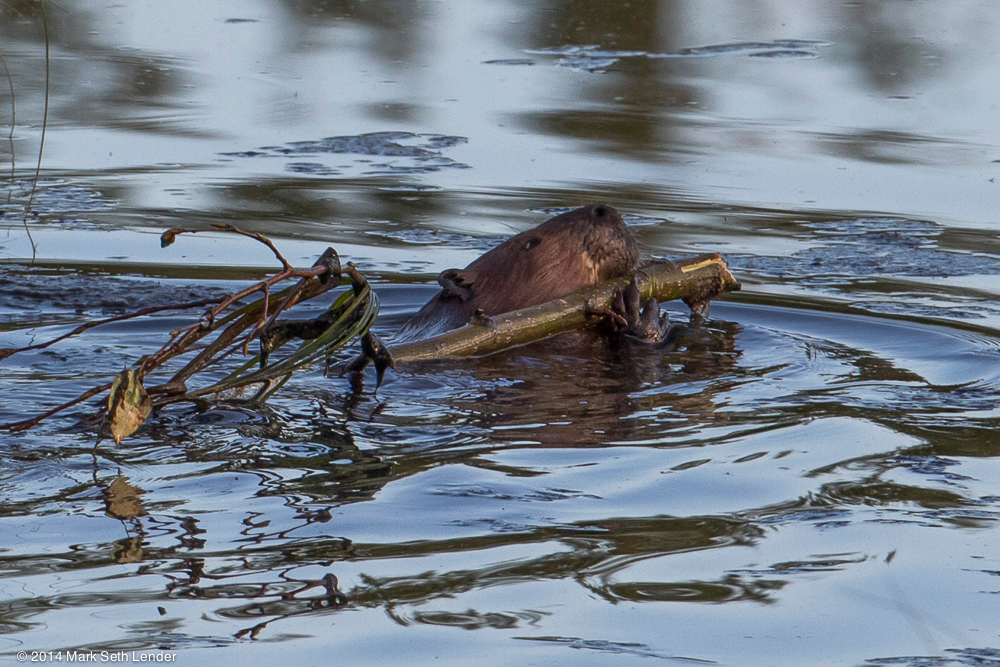Elk Island: A World Less Apart
Air Date: Week of May 22, 2015

The Plains Bison have moved into the wood, the Wood Bison onto the plain. (Photo: Mark Seth Lender)
The bison, beaver, and coyote of Elk Island National Park live according to the stark realities of nature, but as writer Mark Seth Lender observes, on the other side of a wooded curtain, an unseen industrial threat looms.
Transcript
CURWOOD: Well, a landscape changing due to our continued reliance on fossil fuels is yet another challenge for wildlife in tough climates. That’s what writer Mark Seth Lender found in Elk Island National Park in Alberta last fall as its creatures prepared for the rugged Canadian winter.

A calf has been licked clean by his mother, and already there are burrs clinging to his fur. (Photo: Mark Seth Lender)
LENDER: The Plains Bison have moved into the wood. The Wood Bison amble out upon the plain, to the edge of the shallow pond still as an open page on a warm end of summer day. And not a cloud in the whole entire sky. They bow to the grass and graze; hard to imagine they are not tame. A calf comes gamboling, the soft hair all around the eyes and ears and the back of his neck peaked and ruffled as a heavy cotton towel. He has been washed and washed by his mother with her broad blue tongue that is rough and soft at the same time. Already there are burrs and bristles clinging to his cheeks and chin. But the calf does not have a care, not a care in the world.
But now as the day goes dim, in a quiet of nearby water, beaver are at work. There, is no rest, and there, is worry. The beaver though their fur is sleek and they are fat with summer know what is coming. Their pond will freeze, hard as concrete. Their larder will last - or they will starve - and they know that also. The sound of teeth and industrious fingered paws softens the dusky air with the cutting and the carrying in (leaves and stems and branches), through all the dangers they must brave in the gathering.
A coyote appears.

A coyote appears, yawning and yipping, then moves on, unaware of the nearby trucks rushing north to deliver drilling supplies. (Photo: Mark Seth Lender)
He clambers onto the dirt road, looks up and down and with a short yawn, and a yip, is on his way. The beavers slap their tails as he passes and then continue, paddling from lodge to shore. The aspens on the other bank are already yellowing.
The Plains Bison have grown very still. One, a great bull, raises his head. His nostrils flare and close, and open. He turns to look at something he knows is there but cannot see…

The beaver industriously stock their larder for the coming winter. (Photo: Mark Seth Lender)
Outside on the high road, all night, now, and all the day before the short bed trucks are rolling, their backs burdened with pipes and fittings; the eighteen-wheelers heavy with machines and rigging; the pickups with their pipe-fitter crews and their kit, and all of them racing, racing north, turning tar and sand into the end of the world as it was and we once knew it.
CURWOOD: Writer Mark Seth Lender, and there are some of his photographs at our website, LOE.org.
Links
Fraserway RV provided Lender's transportation
Additional support for Mark's fieldwork was provided by Travel Alberta
Living on Earth wants to hear from you!
Living on Earth
62 Calef Highway, Suite 212
Lee, NH 03861
Telephone: 617-287-4121
E-mail: comments@loe.org
Newsletter [Click here]
Donate to Living on Earth!
Living on Earth is an independent media program and relies entirely on contributions from listeners and institutions supporting public service. Please donate now to preserve an independent environmental voice.
NewsletterLiving on Earth offers a weekly delivery of the show's rundown to your mailbox. Sign up for our newsletter today!
 Sailors For The Sea: Be the change you want to sea.
Sailors For The Sea: Be the change you want to sea.
 The Grantham Foundation for the Protection of the Environment: Committed to protecting and improving the health of the global environment.
The Grantham Foundation for the Protection of the Environment: Committed to protecting and improving the health of the global environment.
 Contribute to Living on Earth and receive, as our gift to you, an archival print of one of Mark Seth Lender's extraordinary wildlife photographs. Follow the link to see Mark's current collection of photographs.
Contribute to Living on Earth and receive, as our gift to you, an archival print of one of Mark Seth Lender's extraordinary wildlife photographs. Follow the link to see Mark's current collection of photographs.
 Buy a signed copy of Mark Seth Lender's book Smeagull the Seagull & support Living on Earth
Buy a signed copy of Mark Seth Lender's book Smeagull the Seagull & support Living on Earth

